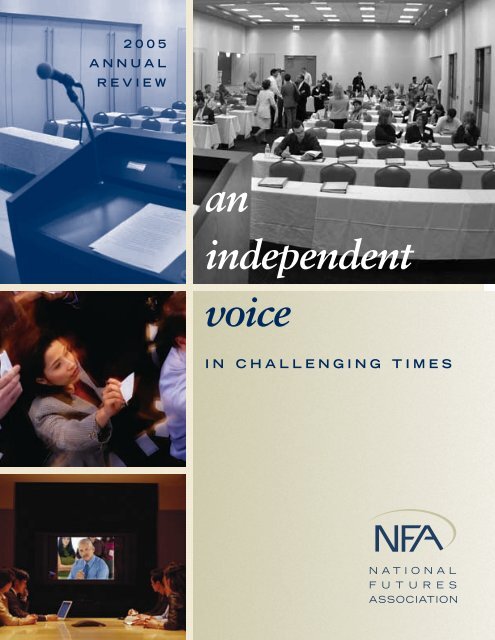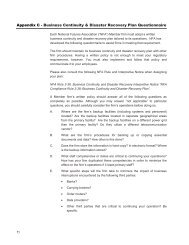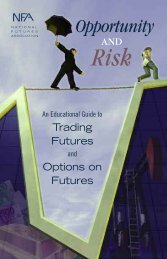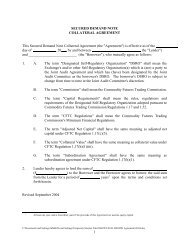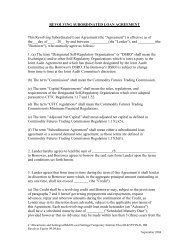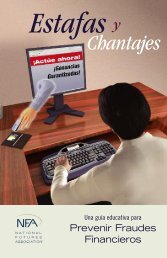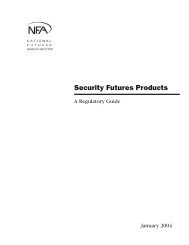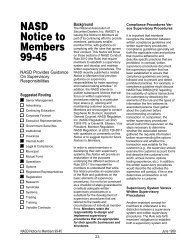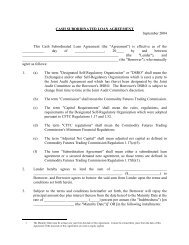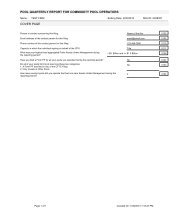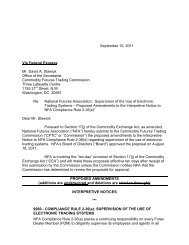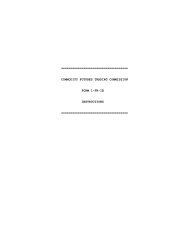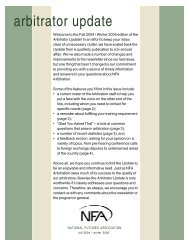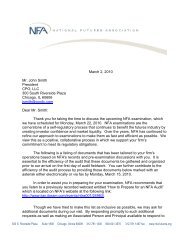2005 Annual Review - National Futures Association
2005 Annual Review - National Futures Association
2005 Annual Review - National Futures Association
Create successful ePaper yourself
Turn your PDF publications into a flip-book with our unique Google optimized e-Paper software.
<strong>2005</strong><br />
ANNUAL<br />
REVIEW<br />
an<br />
independent<br />
voice<br />
IN CHALLENGING TIMES
a letter<br />
FROM THE CHIEF EXECUTIVE OFFICER AND CHAIRMAN OF THE BOARD<br />
These are extraordinary times for the futures industry. Arguably, we have never before experienced such a sustained<br />
period of dramatic growth in trading volume. Lower fees, new contracts and easier access to the markets have all<br />
contributed to the industry’s continuing success.<br />
These are also challenging times. Although this <strong>Annual</strong> <strong>Review</strong> highlights NFA’s accomplishments during our most<br />
recent fiscal year (July 1, 2004 through June 30, <strong>2005</strong>), we are going to press just as news of an accounting irregularity<br />
involving Refco, Inc., the parent company of an FCM Member of NFA, is emerging. The investigation is in its early<br />
stages, but the repercussions are already being felt, fueled by some inaccurate initial media coverage.<br />
Some newspaper and magazine articles suggested that the Refco situation was a result of ineffective regulation in<br />
the futures industry. This is simply not true. While some of Refco’s affiliates ceased operations, its business as a regulated<br />
<strong>Futures</strong> Commission Merchant continued to meet all of its obligations. The regulatory safeguards in place in the<br />
futures industry–segregated customer funds, daily clearing of all trades, minimum financial requirements–helped to<br />
assure futures customers that their funds at Refco LLC were secure. In fact, these safeguards, combined with vigilant<br />
supervision by the CFTC, the Chicago Mercantile Exchange (Refco’s designated self-regulatory organization) and NFA,<br />
demonstrated the industry’s regulatory strengths.<br />
The challenge the futures industry faces as a result of the events at Refco is to sustain the public’s confidence in<br />
the futures markets by combating false or misleading information. The industry needs to say loudly and clearly that the<br />
futures markets and the firms and individuals who work in the futures markets are held to the highest standards of<br />
business practice.<br />
The industry should have no problem echoing these sentiments because the principle of market integrity is<br />
something we all agree on. Speaking with a unified voice on other issues, however, is sometimes difficult. This is an<br />
industry with a broad spectrum of constituents. FCMs, CPOs, CTAs, IBs, the futures exchanges, the CFTC, trade<br />
associations–all speak with voices that reflect their particular business needs and goals.<br />
Amidst all these voices, we believe NFA’s is unique. We are an independent self-regulatory organization. We do not<br />
operate an exchange, and we are not a lobbying organization. Regulation is all we do, and we are committed to<br />
providing the most efficient and effective regulation possible.<br />
This past year the industry’s voices were focused on another issue that remains unresolved as we go to press–the<br />
CFTC’s reauthorization. This year’s reauthorization has witnessed a wide range of opinions and recommendations, especially<br />
regarding the issue of clarifying the CFTC’s jurisdiction over the retail off-exchange foreign currency (forex) market.<br />
When invited to speak at congressional hearings last year, we took an independent stand by proposing amendments to<br />
the Commodity Exchange Act to ensure that off-exchange retail forex transactions–as well as other products that look like<br />
futures, act like futures and are sold like futures–are within the CFTC’s jurisdiction. We also proposed an amendment to the<br />
Act to prohibit unregulated persons from soliciting retail off-exchange forex transactions or managing retail forex accounts.<br />
In addition to our testimony at congressional hearings, we met individually with congressional leaders and their<br />
staff, as well as the President’s Working Group. We also had many discussions with industry and government<br />
representatives to try to reach a consensus. We will continue to voice our concerns and to collaborate with others in<br />
the industry to reach a workable solution.<br />
Most importantly, we will use our independent voice to tell the industry and the world that self-regulation in the<br />
futures industry has been and will continue to be successful in safeguarding market integrity and protecting investors.<br />
Our voice will always be raised in pursuit of those goals.<br />
Daniel J. Roth<br />
President and CEO<br />
Michael R. Schaefer<br />
Chairman of the Board<br />
2<br />
NFA<br />
<strong>2005</strong> ANNUAL REVIEW
INTRODUCTION<br />
NFA’s voice has many facets:<br />
an auditor discussing the results of an<br />
examination with an NFA Member; an<br />
attorney presenting an enforcement case<br />
to the members of NFA’s Business Conduct<br />
Committee; an Information Center<br />
Representative answering questions from<br />
Members and investors; a systems developer<br />
collaborating with end users on a new<br />
system that will increase efficiency. All of<br />
these voices belong to skilled, experienced<br />
employees who help NFA accomplish its<br />
corporate mission and goals. They are<br />
professional, knowledgeable and united<br />
behind a common goal–market integrity<br />
and investor protection.<br />
A Forceful Voice 4<br />
A Constructive Voice 4<br />
A Pragmatic Voice 7<br />
An Independent Voice 8<br />
NFA Officers & Board of Directors 10<br />
<strong>2005</strong> Financials 12<br />
About NFA 19<br />
NFA Chairman of the Board Michael R. Schaefer (left) and<br />
NFA President and CEO Daniel J. Roth.<br />
This report highlights NFA’s Fiscal Year <strong>2005</strong><br />
(July 1, 2004 through June 30, <strong>2005</strong>)<br />
3
A Forceful Voice<br />
Strong rulemaking and vigilant rule<br />
enforcement are essential to self-regulatory<br />
success. During Fiscal Year <strong>2005</strong>,<br />
NFA amended existing rules and developed<br />
new regulations to address the<br />
needs of the industry. We also took<br />
several disciplinary actions necessary to<br />
maintain the integrity of the futures<br />
markets.<br />
Much of our rulemaking initiatives during<br />
the past year focused on the offexchange<br />
retail forex markets, which<br />
continue to experience dramatic growth.<br />
At the beginning of our fiscal year (July<br />
1, 2004), we had registered 17 active<br />
Forex Dealer Members holding approximately<br />
$430 million in customer funds.<br />
Twelve months later, we had 28 active<br />
Forex Dealer Members holding approximately<br />
$610 million.<br />
Since NFA’s initial forex rules and<br />
Interpretive Notice became effective in<br />
December 2003, we have closely monitored<br />
the rules’ viability and effectiveness.<br />
Last year, we amended two<br />
Interpretive Notices to require Forex<br />
Dealer Members to disclose the bid-ask<br />
spread to their customers and to clarify<br />
that NFA’s enhanced supervisory requirements<br />
also apply to the retail forex<br />
activities of Members subject to NFA<br />
Compliance Rule 2-36.<br />
Realizing that additional regulatory<br />
action was needed, we appointed a<br />
Special Committee to Study Customer<br />
Protection Issues in November 2004.<br />
The committee, comprised of industry<br />
and public representatives, was given the<br />
responsibility to address a variety of<br />
issues, beginning with retail off-exchange<br />
forex transactions.<br />
Under the committee’s guidance, we<br />
developed additional rules that will<br />
become effective in FY 2006, including a<br />
requirement for Forex Dealer Members<br />
to provide their customers with written<br />
information regarding NFA’s Background<br />
Affiliation Status Information<br />
Center (BASIC) system when the customer<br />
first opens an account and at least<br />
once a year thereafter and rule amendments<br />
designed to strengthen the capital<br />
requirements for Forex Dealer Members.<br />
Another developing trend in the futures<br />
industry is the increasing number of NFA<br />
Member firms that offer trade execution<br />
services to customers who use computerized<br />
trading systems. Since many of the<br />
developers of the systems are not required<br />
to register with the CFTC, NFA developed<br />
an Interpretive Notice addressing<br />
the responsibilities an NFA Member has<br />
when conducting business with these<br />
entities. In particular, the Notice outlines<br />
the conditions under which an NFA<br />
Member may be held accountable for<br />
misleading promotional material.<br />
We are always evaluating the effectiveness<br />
of our rules, and when we discover<br />
individuals or firms attempting to evade<br />
a rule, we take action. For example, NFA<br />
Compliance Rule 2-6 prohibits a<br />
Member or Associate from conducting<br />
commodity futures business with a suspended<br />
Member or Associate during the<br />
period of suspension unless otherwise<br />
authorized. In the last few years, NFA<br />
has encountered several instances where<br />
brokers who have been barred from<br />
NFA membership as a result of an NFA<br />
sales practice case have continued to<br />
work at a Member firm. When questioned,<br />
these individuals claimed they<br />
were not involved in the firm’s “commodity<br />
futures business” and were therefore<br />
not subject to the rule.<br />
To address this issue, NFA amended Rule<br />
2-6 to extend the prohibition to expelled<br />
Members in addition to suspended<br />
Members. We also developed an<br />
Interpretive Notice, “Conducting<br />
Commodity <strong>Futures</strong> Business with an<br />
Expelled or Suspended Member or<br />
Associate,” that defines “commodity<br />
futures business” as any and all activities<br />
performed on behalf of, and in connection<br />
with, an NFA Member’s futures<br />
business, including acting as employees,<br />
consultants, independent contractors<br />
agents or unpaid volunteers.<br />
A Constructive Voice<br />
Since its inception, NFA’s philosophy has<br />
been that it is more beneficial to prevent<br />
rule violations than to prosecute them.<br />
During this past year NFA developed<br />
additional materials to help our Members<br />
meet their regulatory responsibilities.<br />
In the last few years, Members have had<br />
to contend with several new regulations<br />
(anti-money laundering programs,<br />
forex, disaster recovery, privacy and others).<br />
Responding to feedback from<br />
Members asking for more guidance on<br />
these issues, NFA developed questionnaires<br />
for anti-money laundering,<br />
disaster recover, privacy rules and<br />
ethics training. Firms can use these<br />
questionnaires to help them ensure<br />
that their procedures cover all the<br />
required areas. Each questionnaire is<br />
attached as an appendix to NFA’s<br />
Self-Examination Checklist or can be<br />
downloaded individually from NFA’s<br />
Web site (www.nfa.futures.org).<br />
4<br />
NFA<br />
<strong>2005</strong> ANNUAL REVIEW
One of the primary ways NFA detects rule<br />
violations is through audits of Member<br />
firms. During FY <strong>2005</strong>, we conducted over<br />
650 examinations, looking at all aspects of<br />
a firm’s business. In over 30 percent of the<br />
examinations, we noted no concerns. In<br />
over 60 percent, the audits revealed routine<br />
deficiencies, which the firms corrected in a<br />
timely manner.<br />
In only seven percent of the examinations<br />
did we find serious violations. Last year we<br />
issued Complaints against 76 respondents<br />
and issued 20 Decisions resolving charges<br />
against 33 respondents. We ordered 10<br />
expulsions and 9 suspensions.<br />
An important aspect of our enforcement<br />
efforts is the collaborative work we do<br />
with other agencies. Several Compliance<br />
staff testified last year in cases for the<br />
CFTC, many of which were taken by the<br />
CFTC as a result of our own enforcement<br />
efforts. We also collaborated on a case<br />
with the New Jersey U.S. Attorney’s Office<br />
and provided expert witness testimony in<br />
several other cases. In addition, we assisted<br />
in several criminal prosecutions, including<br />
the case against Philadelphia Alternative Asset<br />
Management Co. LLC, located in Philadelphia,<br />
and its principal, Paul M. Eustace.<br />
A Coordinated Compliance Campaign<br />
Throughout NFA’s history, our Business<br />
Conduct Committee (BCC) has fined or<br />
expelled a disproportionate number of firms<br />
located in South Florida. Although we have<br />
made significant strides in reducing the number<br />
of firms that violate our sales practice<br />
rules (customer complaints have decreased<br />
by 70% since we began operations), South<br />
Florida continues to be a problem area.<br />
In FY <strong>2005</strong> we staged a coordinated<br />
compliance campaign focused on firms in<br />
South Florida. First, we surveyed 1,100<br />
customers of the firms to help us identify<br />
potential problems. If a customer indicated a<br />
problem, NFA staff telephoned the customer<br />
to conduct an in-depth interview.<br />
Then, over a two-week period in November<br />
2004, audit teams conducted on-site investigations<br />
at 20 active firms. Since that time,<br />
NFA has developed cases against nearly 50<br />
percent of the firms we investigated and has<br />
presented seven of the cases to the BCC.<br />
We appointed a<br />
Special Committee<br />
to Study Customer<br />
Protection Issues to<br />
address a variety of<br />
issues, beginning<br />
with retail offexchange<br />
forex<br />
transactions.<br />
NFA employees (from left)<br />
Vilia Sutkus-Kiela, Todd Joseph,<br />
William Gerlesits and<br />
Lisa Marlow<br />
5
Helping Investors Reclaim<br />
Some of Their Losses<br />
NFA’s restitution service, which usually<br />
applies to judgments awarded in CFTC cases,<br />
helps investors receive some of the money<br />
they have lost due to investment fraud.<br />
Sometimes the logistics of returning the<br />
money can be quite challenging.<br />
In June 2003, for example, the CFTC asked<br />
NFA to be the court-appointed monitor in a<br />
ten-year old case. Working only with boxes of<br />
customer account forms that did not include<br />
customer names or addresses, a team of NFA<br />
employees went through the arduous process<br />
of identifying eligible customers and then<br />
attempting to locate them.<br />
Through our efforts we located more than<br />
500 investors, and in November 2004 we<br />
distributed more than $200,000 to those<br />
individuals.<br />
“Issues and Answers” Member meetings<br />
have been a highly successful program for<br />
NFA over the past three years. At these<br />
meetings, NFA staff members discuss new<br />
rules and regulations, describe common<br />
audit deficiencies and how to avoid them,<br />
and field questions from the audience.<br />
NFA held five “Issues and Answers”<br />
meetings in FY <strong>2005</strong> and will continue the<br />
program in 2006.<br />
“Issues and Answers”<br />
Member meetings<br />
have been a highly<br />
successful program–<br />
NFA staff members<br />
discuss new rules and<br />
regulations, describe<br />
common audit deficiencies<br />
and how to<br />
avoid them, and<br />
field questions.<br />
NFA employees (from left)<br />
Cleo Cowans, Suzanne Cech,<br />
Cecilia Krueger and<br />
Scott Reeves<br />
6<br />
NFA<br />
<strong>2005</strong> ANNUAL REVIEW
NFA’s education programs are also<br />
becoming increasingly popular internationally.<br />
Last year, NFA staff members<br />
traveled to India to present a futures<br />
market regulatory training program to<br />
several groups of regulators. In addition,<br />
representatives from the Chinese<br />
<strong>Futures</strong> <strong>Association</strong> and the China<br />
Securities Regulatory Commission<br />
traveled to Chicago for a two-week<br />
training program.<br />
Two of NFA’s most important educational<br />
resources—available to Members,<br />
investors and others with an interest<br />
in the futures industry—are our<br />
Information Center and Web site.<br />
Every month Information Center<br />
Representatives receive approximately<br />
4,500 telephone calls, and visitors to our<br />
Web site access nearly one million<br />
pages of information.<br />
An important component of our Web<br />
site is the Background Affiliation Status<br />
Information Center (BASIC), an extensive<br />
database of registration and disciplinary<br />
information on futures firms and<br />
individuals. Last year, NFA Members<br />
and the investing public conducted more<br />
than 600,000 BASIC searches.<br />
We continue to expand the information<br />
and services available on our Web site.<br />
Last year we launched an e-mail subscription<br />
service to allow individuals to<br />
receive Notices to Members, Advisories<br />
and other compliance-related information<br />
as it is published.<br />
Our participation in the International<br />
Traders Expos provides many opportunities<br />
for us to meet with individual<br />
investors. The three-day conferences,<br />
held in various cities around the country,<br />
offer many educational sessions and<br />
each Expo attracts approximately 5,000<br />
individuals. Reflecting our increased<br />
presence at the Expos, NFA staff has<br />
been invited to speak at various educational<br />
sessions offered during the event.<br />
The services we provide investors are<br />
not limited to education. Investors continue<br />
to turn to NFA’s arbitration and<br />
mediation services to resolve their<br />
futures-related disputes. During the past<br />
fiscal year, NFA received 169 arbitration<br />
claims. The average turnaround<br />
time for an arbitration case was less than<br />
seven months.<br />
One of the most rewarding customer<br />
service initiatives is our restitution program.<br />
The program, which usually<br />
applies to judgments awarded in CFTC<br />
cases, helps investors recover some of<br />
the money they have lost due to investment<br />
fraud. During Fiscal Year <strong>2005</strong>,<br />
NFA distributed more than $2.4 million<br />
in restitution funds to over 3,000<br />
investors. In addition, we collected<br />
$151,000 in civil monetary penalties<br />
for the CFTC.<br />
A Pragmatic Voice<br />
Simply put, NFA likes to solve problems,<br />
not create them. We are always<br />
examining issues—both internally and<br />
externally—to determine what changes<br />
can be made to bring more clarity and<br />
efficiency to industry programs and<br />
procedures.<br />
For example, we developed a pilot<br />
program for Commodity Pool<br />
Operators to file their pool financial<br />
statements electronically through our<br />
Web-based EasyFile system. During this<br />
voluntary program over 15% of the<br />
2004 statements were filed through<br />
EasyFile, and NFA received very positive<br />
feedback from the CPOs who used the<br />
system.<br />
Due to the success of the pilot program,<br />
we decided to make EasyFile mandatory<br />
for the December 31, <strong>2005</strong> filings. We<br />
have requested the CFTC make the rule<br />
changes that will require electronic filing<br />
and eliminate the need for manual signatures.<br />
Not only will EasyFile simplify the<br />
filing process for CPOs, it will also<br />
reduce the time it takes NFA staff to<br />
review pool financial statements.<br />
We also redesigned the data entry modules<br />
for the Background Affiliation<br />
Status Information Center (BASIC) system.<br />
NFA, the CFTC and the U.S.<br />
futures exchanges all contribute registration<br />
and disciplinary information to the<br />
BASIC database. The entry of case information<br />
by all of these contributors is<br />
now easier, quicker and more efficient.<br />
7
As we reported earlier in this publication,<br />
our restitution service helps<br />
investors recover money from judgments<br />
awarded in CFTC cases. Last year we<br />
automated most of the processes relating<br />
to the administration of restitution<br />
orders. The Restitution Processing<br />
System provides an efficient method of<br />
maintaining addresses and contact information<br />
for all parties involved in the<br />
case and provides tools for calculating<br />
the amount of restitution each harmed<br />
investor will receive whenever a distribution<br />
is made.<br />
In 2002 we launched our Online<br />
Registration System (ORS) to increase<br />
registration efficiencies and reduce the<br />
amount of paper files that NFA and<br />
Member firms were required to maintain.<br />
Last year we developed a quality<br />
assurance program in which we review<br />
information entered into ORS for<br />
erroneous, inaccurate or problematic<br />
information. In addition, we made<br />
several enhancements to ORS as a result<br />
of feedback from our Members. Most<br />
notably, we developed a new feature to<br />
allow ORS security managers at<br />
Member firms to reset their passwords<br />
by providing answers to questions<br />
entered into the system when they<br />
enrolled.<br />
The issues NFA addresses are not limited<br />
to internal policies and work processes.<br />
For example, we led an industrywide<br />
effort to harmonize the use of Customer<br />
Transaction Indicator codes among<br />
the various exchanges. The result of<br />
this collaboration provided <strong>Futures</strong><br />
Commission Merchants with a clearer<br />
understanding of the situations in which<br />
each type of code should be utilized,<br />
allowing for better tracking of trading<br />
activity across all exchanges.<br />
Compliance staff also met with NASD<br />
staff to coordinate joint audits of those<br />
firms that are dually registered on both<br />
the futures and securities sides and<br />
reduce the regulatory burden on our<br />
Members. In addition, NFA Compliance<br />
An Independent Voice<br />
Throughout NFA’s most recent fiscal<br />
year, the CFTC conducted a review of<br />
self-regulation in the futures industry.<br />
Although the CFTC has not yet published<br />
the results of its review, we are<br />
certain it will underline the importance of<br />
an SRO’s unbiased disciplinary processes,<br />
free of any hint of conflict of interest.<br />
NFA has always had safeguards in place<br />
to ensure that our disciplinary process is<br />
fair and impartial. Our rules state that<br />
no committee or panel member can participate<br />
in a disciplinary matter if the<br />
member, or any person with which the<br />
member is connected, has a financial, personal<br />
or other direct interest in the matter.<br />
Traditionally, NFA has also ensured that<br />
both the Business Conduct Committee<br />
and the Hearing Committee include individuals<br />
who are not NFA Members or<br />
Associates.<br />
In FY <strong>2005</strong>, we amended our Bylaws to<br />
codify our current practice by requiring<br />
that at least two-thirds of both committees<br />
be non-Member representatives and<br />
by including employees of NFA<br />
Members as Member representatives.<br />
We have also applied these same safeguards<br />
to the registration and membership<br />
process. We divide our Membership<br />
Committee into three-person Designated<br />
Subcommittees to conduct hearings and<br />
consider settlement offers. To ensure uniformity<br />
in treatment of similarly situated<br />
applicants, the Membership Committee<br />
meets quarterly to review the activities of<br />
these Designated Subcommittees. In<br />
addition, we amended Bylaw 701 to<br />
require at least one-third of the<br />
Membership Committee to be non-<br />
Members and amended Registration<br />
Rule 501 to require at least one member<br />
of each Designated Subcommittee to be a<br />
non-Member.<br />
In the years ahead, we will continue to<br />
take whatever actions are necessary to<br />
ensure our unbiased, independent<br />
stature. It is a contributing factor in the<br />
public’s ongoing confidence in the<br />
futures markets, and it is crucial to NFA’s<br />
continued success.<br />
8<br />
NFA<br />
<strong>2005</strong> ANNUAL REVIEW
staff is currently leading a coordinated<br />
effort between the Joint Audit Committee<br />
and Joint Compliance Committee to<br />
research regulatory issues relating to trading<br />
arcades and proprietary accounts.<br />
Last year we developed<br />
a quality assurance<br />
program in which we<br />
review information<br />
entered into ORS for<br />
erroneous, inaccurate<br />
or problematic<br />
information.<br />
Portal Technology Enhances<br />
Information Sharing<br />
During the past year NFA implemented<br />
a portal technology that has helped staff<br />
members share information and reduce<br />
workflow inefficiencies. Each department<br />
developed its own portal which can then be<br />
accessed by every NFA employee. The portal<br />
sites enable staff to communicate more<br />
easily and increase productivity.<br />
For example, the Information Systems<br />
department uses its portal site for project<br />
development, capacity planning and problem<br />
tracking. The Compliance department<br />
archives audit reports directly to the portal<br />
and tracks audit team activity more efficiently.<br />
Communications and Education’s News<br />
Center portal centralized the publication of<br />
many NFA information resources, reducing<br />
the number of emails sent to staff.<br />
During the coming year we will adopt additional<br />
enhancements to the portal system to<br />
develop a workflow architecture which joins<br />
documents, emails and applications in an<br />
easily manageable environment.<br />
NFA employees (from left)<br />
Kim Heitzman, John Brodersen,<br />
Darlene Chappell, Kristin Leigel and<br />
David McKenzie<br />
9
Officers & Board of Directors<br />
Officers<br />
Directors<br />
As of June 30, <strong>2005</strong><br />
Daniel J. Roth*<br />
President & CEO<br />
Daniel A. Driscoll<br />
Exec. Vice-President<br />
Chief Operating Officer<br />
Michael R. Schaefer*<br />
Chairman of the Board<br />
Managing Director<br />
Citigroup Global Markets, Inc.<br />
Douglas O. Kitchen*<br />
Vice-Chairman of the Board<br />
Managing Director<br />
Rosenthal Collins Group LLC<br />
Kenneth F. Haase<br />
Sr. Vice-President<br />
Information Systems<br />
Karen K. Wuertz<br />
Sr. Vice-President<br />
Strategic Planning<br />
and Communications<br />
Commodity Pool Operator and<br />
Commodity Trading Advisor<br />
Representatives<br />
Bruce L. Cleland*<br />
President & CEO<br />
Campbell & Company<br />
George E. Crapple*<br />
Co-Chairman & Co-CEO<br />
The Millburn Corp.<br />
David Hawrysz<br />
Vice-President<br />
Treasurer<br />
Gregory C. Prusik<br />
Vice-President<br />
Registration<br />
James R. Klingler<br />
Senior Vice-President<br />
Eclipse Capital<br />
Management, Inc.<br />
Robert E. Murray<br />
Chief Operating Officer<br />
Graham Capital<br />
Management LP<br />
Thomas Sexton III<br />
Vice-President<br />
General Counsel<br />
& Secretary<br />
Regina Thoele<br />
Vice-President<br />
Compliance<br />
Introducing Broker Representatives<br />
Robert K. Wilmouth<br />
Special Policy Advisor<br />
Paul J. Georgy<br />
President<br />
Allendale, Inc.<br />
John A. Vassallo<br />
President<br />
Coquest, Inc.<br />
10<br />
NFA<br />
<strong>2005</strong> ANNUAL REVIEW<br />
* Member of the Executive Committee
<strong>Futures</strong> Commission Merchant Representatives<br />
Special Advisor<br />
Scott A. Cordes<br />
President<br />
Country Hedging, Inc.<br />
Kevin R. Davis<br />
Chairman & CEO<br />
Man Financial, Inc.<br />
James Davison<br />
Chief Executive Officer<br />
Refco Investment Services<br />
W. Robert Felker*<br />
Chairman<br />
JPMorgan <strong>Futures</strong>, Inc.<br />
Leo Melamed<br />
Permanent Special Advisor to the<br />
Board & Executive Committee<br />
Christopher K. Hehmeyer<br />
Co-Chairman<br />
Goldenberg Hehmeyer & Co.<br />
Douglas O. Kitchen*<br />
Managing Director<br />
Rosenthal Collins Group LLC<br />
Bonnie Litt*<br />
Managing Director &<br />
Associate General Counsel<br />
Goldman Sachs & Co.<br />
Michael R. Schaefer*<br />
Managing Director<br />
Citigroup Global Markets, Inc.<br />
Public Representatives<br />
Alan J. Dixon<br />
Attorney<br />
Bryan Cave<br />
Thomas W. Ewing<br />
Attorney<br />
Davis & Harman LLP<br />
Silas Keehn<br />
Past President<br />
Federal Reserve Bank<br />
of Chicago<br />
Todd E. Petzel*<br />
Managing Director<br />
Azimuth Trust<br />
Company, LLC<br />
Susan M. Phillips<br />
Dean<br />
School of Business<br />
The George Washington University<br />
Exchange Representatives<br />
Mark G. Bagan<br />
President & CEO<br />
Minneapolis Grain<br />
Exchange<br />
Jeffrey C. Borchardt<br />
President & CEO<br />
Kansas City Board<br />
of Trade<br />
Bernard W. Dan*<br />
President & CEO<br />
Chicago Board of Trade<br />
James E. Newsome*<br />
President<br />
New York Mercantile<br />
Exchange<br />
Joseph J. O’Neill<br />
Sr. Exec. Vice-President<br />
New York Board<br />
of Trade<br />
John F. Sandner<br />
Special Policy Advisor<br />
Chicago Mercantile<br />
Exchange<br />
11
<strong>2005</strong> F I N A N C I A L S<br />
Independent Auditors’ Report<br />
To the Board of Directors of<br />
<strong>National</strong> <strong>Futures</strong> <strong>Association</strong>:<br />
We have audited the accompanying statements of financial position of <strong>National</strong> <strong>Futures</strong> <strong>Association</strong><br />
(the “<strong>Association</strong>”) as of June 30, <strong>2005</strong> and 2004, and the related statements of unrestricted revenues,<br />
expenses and changes in unrestricted net assets, and cash flows for the years then ended. These financial<br />
statements are the responsibility of the <strong>Association</strong>’s management. Our responsibility is to express an<br />
opinion on these financial statements based on our audits.<br />
We conducted our audits in accordance with auditing standards generally accepted in the United<br />
States of America. Those standards require that we plan and perform the audit to obtain reasonable<br />
assurance about whether the financial statements are free of material misstatement. An audit includes<br />
consideration of internal control over financial reporting as a basis for designing audit procedures that<br />
are appropriate in the circumstances, but not for the purpose of expressing an opinion on the effectiveness<br />
of the <strong>Association</strong>’s internal control over financial reporting. Accordingly, we express no such opinion.<br />
An audit also includes examining, on a test basis, evidence supporting the amounts and disclosures in<br />
the financial statements, assessing the accounting principles used and significant estimates made by<br />
management, as well as evaluating the overall financial statement presentation. We believe that our<br />
audits provide a reasonable basis for our opinion.<br />
In our opinion, such financial statements present fairly, in all material respects, the financial<br />
position of <strong>National</strong> <strong>Futures</strong> <strong>Association</strong> as of June 30, <strong>2005</strong> and 2004, and the changes in its net assets<br />
and its cash flows for the years then ended in conformity with accounting principles generally accepted<br />
in the United States of America.<br />
August 2, <strong>2005</strong><br />
12<br />
NFA<br />
<strong>2005</strong> ANNUAL REVIEW
STATEMENTS OF<br />
FINANCIAL POSITION<br />
Years ended June 30, <strong>2005</strong> and 2004<br />
Assets<br />
Current Assets:<br />
Cash and cash equivalents, including $8,614,066 and$12,766,270<br />
of interest-bearing deposits in <strong>2005</strong> and 2004, respectively<br />
Short-term investments<br />
Accrued interest<br />
Assessments receivable<br />
Other current assets<br />
Total current assets<br />
<strong>2005</strong><br />
$ 10,014,066<br />
6,272,504<br />
270,269<br />
2,308,295<br />
993,376<br />
19,858,510<br />
2004<br />
$ 13,366,270<br />
3,568,185<br />
210,368<br />
2,865,903<br />
903,132<br />
20,913,858<br />
Long-Term Investments<br />
Furniture, Fixtures, Equipment, Leasehold Improvements<br />
and Software–<br />
At cost–less accumulated depreciation and amortization<br />
Other Assets<br />
Total assets<br />
21,834,573<br />
5,273,233<br />
2,402,028<br />
$ 49,368,344<br />
19,721,656<br />
6,100,318<br />
2,416,474<br />
$ 49,152,306<br />
Liabilities and Net Assets<br />
Current Liabilities:<br />
Unearned dues and fees<br />
Accounts payable, accrued expenses and other current liabilities<br />
Total current liabilities<br />
Deferred Rent Credit<br />
Other Long-Term Liabilities<br />
Total liabilities<br />
Unrestricted Net Assets<br />
Total Liabilities and Net Assets<br />
$ 550,368<br />
2,686,751<br />
3,237,119<br />
705,925<br />
3,495,343<br />
7,438,387<br />
41,929,957<br />
$ 49,368,344<br />
$ 1,189,491<br />
2,090,797<br />
3,280,288<br />
918,158<br />
3,439,965<br />
7,638,411<br />
41,513,895<br />
$ 49,152,306<br />
SEE NOTES TO FINANCIAL STATEMENTS.<br />
13
STATEMENTS OF UNRESTRICTED REVENUES,<br />
EXPENSES AND CHANGES IN UNRESTRICTED NET ASSETS<br />
Years ended June 30, <strong>2005</strong> and 2004<br />
<strong>2005</strong><br />
2004<br />
Unrestricted Revenues:<br />
Assessments<br />
Membership dues<br />
Registration and other fees<br />
Regulatory services outsourcing<br />
Investment income<br />
Total unrestricted revenues<br />
$ 23,589,516<br />
4,245,592<br />
2,745,733<br />
1,538,819<br />
760,638<br />
32,880,298<br />
$ 21,887,247<br />
4,822,094<br />
2,862,467<br />
696,909<br />
323,360<br />
30,592,077<br />
Unrestricted Expenses:<br />
Salaries, wages and employee benefits<br />
Space rental and related expenses<br />
Travel and meetings<br />
Computer expenditures<br />
Depreciation and amortization<br />
Outside consulting fees and services<br />
Supplies, postage and telephone<br />
Outside printing and publications<br />
Board and committee fees and expenses<br />
Insurance, recruiting, education, dues and other<br />
21,190,052<br />
2,517,681<br />
2,170,000<br />
583,855<br />
2,585,707<br />
959,541<br />
384,660<br />
173,965<br />
532,520<br />
1,366,255<br />
19,884,843<br />
2,716,309<br />
2,041,592<br />
529,674<br />
2,828,812<br />
1,035,724<br />
384,402<br />
177,112<br />
343,348<br />
1,285,825<br />
Total unrestricted expenses<br />
32,464,236<br />
31,227,641<br />
Increase (Decrease) In Unrestricted Net Assets<br />
416,062<br />
(635,564)<br />
Unrestricted Net Assets – Beginning of year<br />
41,513,895<br />
42,149,459<br />
Unrestricted Net Assets – End of year<br />
$ 41,929,957<br />
$ 41,513,895<br />
SEE NOTES TO FINANCIAL STATEMENTS.<br />
14<br />
NFA<br />
<strong>2005</strong> ANNUAL REVIEW
STATEMENTS OF<br />
CASH FLOWS<br />
Years ended June 30, <strong>2005</strong> and 2004<br />
<strong>2005</strong><br />
2004<br />
Cash Flows from Operating Activities:<br />
Increase (decrease) in unrestricted net assets<br />
Adjustments to reconcile increase (decrease) in unrestricted<br />
net assets to net cash provided by operating activities:<br />
Net change in unrealized loss on investments<br />
Net realized loss on investments<br />
Depreciation and amortization<br />
Changes in assets and liabilities:<br />
Assessments receivable<br />
Accrued interest<br />
Other assets<br />
Unearned dues and fees<br />
Accounts payable, accrued expenses and other liabilities<br />
Deferred rent credit<br />
Net cash provided by operating activities<br />
$ 416,062<br />
35,576<br />
271,340<br />
2,585,707<br />
557,608<br />
(59,901)<br />
(75,798)<br />
(639,123)<br />
651,332<br />
(212,233)<br />
3,530,570<br />
$ (635,564)<br />
819,504<br />
127,730<br />
2,828,812<br />
(550,004)<br />
22,460<br />
106,150<br />
106,823<br />
(70,179)<br />
(185,428)<br />
2,570,304<br />
Cash Flows from Investing Activities:<br />
Purchases of fixed assets and software<br />
Purchases of securities<br />
Sale of securities<br />
Maturities of U.S. Treasury securities<br />
(1,758,622)<br />
(58,371,407)<br />
31,141,335<br />
22,105,920<br />
(1,475,963)<br />
(20,631,829)<br />
15,692,272<br />
9,425,000<br />
Net cash (used in) provided by investing activities<br />
(6,882,774)<br />
3,009,480<br />
Net (Decrease) Increase In Cash and Cash Equivalents<br />
(3,352,204)<br />
5,579,784<br />
Cash and Cash Equivalents – Beginning of year<br />
13,366,270<br />
7,786,486<br />
Cash and Cash Equivalents – End of year<br />
$10,014,066<br />
$13,366,270<br />
SEE NOTES TO FINANCIAL STATEMENTS.<br />
15
NOTES TO FINANCIAL STATEMENTS Years ended June 30, <strong>2005</strong> and 2004<br />
1. Organization<br />
The Commodity <strong>Futures</strong> Trading Commission has designated<br />
<strong>National</strong> <strong>Futures</strong> <strong>Association</strong> (the “<strong>Association</strong>”) as a registered<br />
futures association. Among the <strong>Association</strong>’s activities are<br />
qualification screening and registration, financial and trade<br />
practice surveillance, enforcement of customer protection rules<br />
and uniform business standards, arbitration of disputes and<br />
educational activities. The <strong>Association</strong> is financed through<br />
the payment of assessments and dues by its members and<br />
registration fees by registrants.<br />
2. Summary of Significant Accounting Policies<br />
Use of Estimates The financial statements of the <strong>Association</strong><br />
have been prepared, using the accrual basis of accounting, in<br />
conformity with accounting principles generally accepted in<br />
the United States of America. The preparation of financial<br />
statements in conformity with generally accepted accounting<br />
principles requires management to use estimates and assumptions<br />
that affect the reported amounts of assets and liabilities at<br />
the date of the financial statements and the reported amounts<br />
of revenues and expenses during the reporting period. Actual<br />
results could differ from the estimates.<br />
Federal Income Taxes The <strong>Association</strong> is exempt from<br />
federal income taxes under Section 501(c)(6) of the U.S.<br />
Internal Revenue Code. The Internal Revenue Service has<br />
issued a determination letter to that effect.<br />
Assessments Assessments are reported monthly and are due<br />
within 30 days. They are recognized as revenue in the month to<br />
which they apply.<br />
Investments Investments are carried at fair market value based<br />
on quoted market prices. Changes in market values are<br />
included in investment income.<br />
Membership Dues Membership dues are nonrefundable and<br />
are recognized as revenue on a pro rata basis over the members’<br />
membership year.<br />
Registration Renewal Fees Registration renewal fees are nonrefundable<br />
and are recognized as revenue on a pro rata basis<br />
over the registrants’ renewal period.<br />
Regulatory Services Outsourcing Regulatory services outsourcing<br />
revenue relates to the <strong>Association</strong>’s market and trade<br />
practice surveillance services. This revenue consists of one-time<br />
nonrefundable fees and monthly fees for ongoing services for<br />
each customer. One-time fees are used by the <strong>Association</strong> to<br />
purchase hardware and software necessary to perform surveillance<br />
services for a given customer and are recognized as<br />
revenue when paid by the customer. Monthly fees and a<br />
transaction fee for ongoing surveillance and other regulatory<br />
services are recognized as revenue on a monthly basis as services<br />
are performed.<br />
Depreciation and Amortization Fixed assets and leasehold<br />
improvements are depreciated over three to seven years or the<br />
term of the lease, if applicable, on a straight-line basis. The<br />
<strong>Association</strong> uses the half-year convention so that the first and<br />
last years of depreciation and amortization are one-half the<br />
straight line amount and all middle years are in direct proportion<br />
to the useful life of the capitalized item.<br />
Purchased Software Purchased software is included in fixed<br />
assets, and is capitalized and amortized over three years on a<br />
straight-line basis using the half-year convention.<br />
Software Design and Development Costs Software design<br />
and development costs consist of salaries and benefits of the<br />
<strong>Association</strong>’s personnel involved in projects to develop software<br />
for internal use. Software design and development costs<br />
incurred in the preliminary stage of a project, as well as<br />
training and maintenance costs, are expensed as incurred.<br />
Software design and development costs associated with the<br />
application development stage of software projects are capitalized<br />
until such time that the software is substantially complete<br />
and ready for its intended use. Capitalized software design and<br />
development costs are amortized over three years on a straightline<br />
basis using the half-year convention.<br />
Deferred Rent Credit Due to the terms of the <strong>Association</strong>’s<br />
primary office space leases, a deferred rent credit was generated.<br />
The deferred rent credit is amortized over the remaining terms<br />
of the respective leases, which range from three to seven years.<br />
The <strong>Association</strong> computed an average monthly rental for the<br />
entire term of each lease and charged this amount to rental<br />
expense each month. The difference between the average<br />
monthly rental and the actual monthly rental payment is<br />
accounted for as either an increase or reduction of the deferred<br />
rent credit.<br />
Allowance for Doubtful Accounts The allowance for doubtful<br />
accounts is maintained at a level that in management’s judgment<br />
is adequate to provide for estimated probable losses related to<br />
receivables. At June 30, <strong>2005</strong> and 2004, the allowance for<br />
doubtful accounts is $354,970 and $145,125, respectively,<br />
and is included in other current assets on the statements of<br />
financial position.<br />
Statement of Cash Flows For the purpose of this statement,<br />
cash and cash equivalents include cash and money market<br />
funds.<br />
3. Investments:<br />
The <strong>Association</strong>’s investment portfolio is classified on the<br />
statements of financial position as short-term and long-term<br />
investments. Short-term investments consist of securities with<br />
maturity dates of one year or less. Long-term investments<br />
consist of securities with maturity dates greater than one year.<br />
Expected maturities will differ from contractual maturities<br />
because borrowers may have a right to call or prepay obligations<br />
with or without call or prepayment penalties.<br />
Management of a portion of the <strong>Association</strong>’s investable funds<br />
has been outsourced to a professional money manager. As of<br />
June 30, <strong>2005</strong> and 2004, approximately 78% and 80%, respectively,<br />
of the total carrying value of investments and money market<br />
funds was outsourced.<br />
16<br />
NFA<br />
<strong>2005</strong> ANNUAL REVIEW
The aggregate carrying amount of investments by major type as<br />
of June 30, <strong>2005</strong> and 2004 is as follows:<br />
<strong>2005</strong> 2004<br />
Short-term:<br />
U.S. Treasury securities $ 3,599,592 $ --<br />
U.S. Government Agency<br />
securities 299,814 1,005,630<br />
Corporate debt obligations 2,373,098 2,562,555<br />
Total short-term 6,272,504 3,568,185<br />
Long-term:<br />
U.S. Treasury securities 3,634,950 6,639,011<br />
U.S. Government Agency<br />
securities 6,067,105 3,146,814<br />
Corporate debt obligations 8,810,479 5,444,375<br />
Asset-backed securities 2,765,968 3,943,009<br />
Mortgage-backed securities 556,071 548,447<br />
Total long-term 21,834,573 19,721,656<br />
Total $28,107,077 $23,289,841<br />
Corporate debt obligations are rated at least A and assetbacked<br />
and mortgage-backed securities at least AA or Aa by<br />
Standard & Poor’s or Moody’s. There are no concentrations<br />
greater than 5% of total investments with one issuer associated<br />
with the investments in corporate debt obligations and assetbacked<br />
and mortgage-backed securities. As of June 30, <strong>2005</strong><br />
and 2004, the average effective duration of the <strong>Association</strong>’s<br />
professionally managed portfolio was approximately 1.53<br />
years and 1.63 years, respectively.<br />
The composition of investment income for the years ended June<br />
30, <strong>2005</strong> and 2004 is as follows:<br />
<strong>2005</strong> 2004<br />
Interest income $1,067,554 $1,270,594<br />
Net realized (loss) gain (271,340) (127,730)<br />
Net change in<br />
unrealized loss (35,576) (819,504)<br />
Total $ 760,638 $ 323,360<br />
4. Furniture, Fixtures, Equipment,<br />
Leasehold Improvements and Software:<br />
Fixed assets consist of the following as of June 30, <strong>2005</strong> and 2004:<br />
<strong>2005</strong> 2004<br />
Furniture and fixtures $ 2,360,844 $ 2,421,103<br />
Equipment 2,286,939 1,965,460<br />
Leasehold improvements 5,763,847 5,681,369<br />
Software 2,869,430 3,660,951<br />
13,281,060 13,728,883<br />
Less accumulated<br />
depreciation and<br />
amortization 8,007,827 7,628,565<br />
Total $ 5,273,233 $ 6,100,318<br />
5. Commitments and Contingencies:<br />
The <strong>Association</strong> leases office space in Chicago and New York.<br />
The Chicago lease expires in 2008 and negotiations are currently<br />
in process for a new lease. In addition, the <strong>Association</strong> has<br />
entered into a 36-month contract with a disaster recovery<br />
service provider. The following is a schedule of future payments<br />
under both the operating leases and the disaster recovery contract<br />
that have remaining noncancellable payment terms in<br />
excess of one year as of June 30, <strong>2005</strong>:<br />
2006 $ 1,676,977<br />
2007 1,775,690<br />
2008 1,419,017<br />
2009 705,953<br />
2010 673,113<br />
Future years 897,484<br />
Total $ 7,148,234<br />
In the normal course of business, the <strong>Association</strong> is, at times,<br />
involved in pending legal proceedings. Management, after consultation<br />
with outside legal counsel, believes that the resolution<br />
of current proceedings will not have a material effect on the<br />
<strong>Association</strong>’s net assets.<br />
6. Employee Benefit Plans:<br />
The <strong>Association</strong> sponsors an Employee Retirement Savings<br />
Plan (the “Savings Plan”). Contributions to the Savings Plan of<br />
up to 100% of employees’ compensation can be made through<br />
payroll deductions. The <strong>Association</strong> will match, dollar for<br />
dollar, employee contributions up to 6% of the employee’s<br />
eligible compensation. The <strong>Association</strong> may also contribute to<br />
the Savings Plan an additional, profitsharing contribution<br />
expressed as a percent of the calendar year’s compensation of<br />
participants who are employed on the last day of the calendar<br />
year. A profit-sharing contribution for 2004 of $692,236 was<br />
made in <strong>2005</strong>. A profit-sharing contribution for 2003 of<br />
$605,604 was made in 2004. Employees are eligible to<br />
participate in the Savings Plan upon their date of hire.<br />
Employee contributions and any vested employer contributions<br />
are payable upon termination or retirement as stipulated in<br />
the Savings Plan.<br />
The <strong>Association</strong> also sponsors the Retiree Medical Benefits<br />
Plan (the “Plan”), which covers substantially all retirees and<br />
their dependents. Effective December 31, 1993, employees who<br />
retire from the <strong>Association</strong> on or after attaining age 55 and<br />
who have at least 10 years of full-time service with the<br />
<strong>Association</strong> are entitled to receive benefits from the Plan.<br />
Individuals who attained age 65 on or before December 31,<br />
1993, who have been employed by the <strong>Association</strong> on a fulltime<br />
basis for at least five years, and who retired after July 1,<br />
1993, were grandfathered under the Plan. The Plan pays a stated<br />
percentage of the cost of medical coverage for employees who<br />
retire prior to age 65. Coverage for employees who have retired<br />
and have reached age 65 is provided under a Medicare<br />
Supplemental Plan. Under the Medicare Supplemental Plan, the<br />
<strong>Association</strong> pays a stated percentage of the supplemental costs.<br />
17
NOTES TO FINANCIAL STATEMENTS Years ended June 30, <strong>2005</strong> and 2004<br />
On July 1, 2003, the Plan’s eligibility requirement and costsharing<br />
schedule was amended. Prior to July 1, 2003, an<br />
employee with at least 10 years of full-time service and who<br />
was at least 55 at retirement was eligible for benefits.<br />
Employees began earning years of service upon employment.<br />
Subsequent to July 1, 2003, the eligibility requirement was<br />
amended to reflect that employees can retire at age 55 or older<br />
but must have at least 10 years of service since their 45th birthday.<br />
All employees will retire having at least 10 years of service<br />
preceding their retirement.<br />
Prior to July 1, 2003, the cost-sharing schedule was based on<br />
age at retirement and years of service. Subsequent to July 1,<br />
2003, the new structure is based on age at retirement. The<br />
following shows the change both prior to and subsequent to the<br />
Plan amendment:<br />
Prior to July 1, 2003<br />
Based on age at retirement and years of service:<br />
Retiree’s Share<br />
Age + Service Pre-65 Post-65<br />
65-69 90% 50%<br />
70-74 80% 40%<br />
75-79 70% 30%<br />
80-84 60% 20%<br />
85+ 50% 10%<br />
Subsequent to July 1, 2003<br />
Based on age at retirement:<br />
Retiree’s Share<br />
Age Pre-65 Post-65<br />
55-59 70% 40%<br />
60-64 60% 30%<br />
65+ 50% 20%<br />
Any employee who retired before August 15, 2003 was given the<br />
choice to convert to the new amendment or be grandfathered<br />
into the pre-amended requirements.<br />
For the years ended June 30, <strong>2005</strong> and 2004, the net periodic<br />
postretirement benefit cost and benefits paid for the Plan are as<br />
the follows:<br />
<strong>2005</strong> 2004<br />
Net periodic postretirement<br />
benefit cost $ 62,219 $ 461,944<br />
Benefits paid 11,101 11,247<br />
The June 30, <strong>2005</strong> and 2004 accumulated postretirement<br />
benefit obligation was determined using an assumed weighted<br />
average discount rate of 5.0% and 6.25%, respectively. The<br />
rate of increase in the gross cost of covered healthcare benefits<br />
was assumed to be 8.0% and 9.0% for fiscal years <strong>2005</strong> and<br />
2004, respectively. The rate of increase is assumed to decline<br />
by 1.00% for each year after <strong>2005</strong> to 5.00% in 2008 and<br />
thereafter.<br />
The <strong>Association</strong> also participates in the purchase of life insurance<br />
on behalf of certain executive officers as part of the<br />
<strong>National</strong> <strong>Futures</strong> <strong>Association</strong> Split Dollar Life Insurance Plan<br />
(the “Split Dollar Plan”). The purpose of the Split Dollar Plan<br />
is to provide participating executive officers with an insured<br />
death benefit during employment and after retirement. The<br />
insurance policy also allows for capital accumulation through<br />
the buildup of cash value. As of June 30, <strong>2005</strong> and 2004, the<br />
cash surrender value is $2,265,511 and $1,990,228, respectively,<br />
and is classified in other assets on the statements of financial<br />
position. The increase in cash surrender value approximately<br />
equals the premiums paid, and approximately all premiums<br />
paid increase the buildup of the cash surrender value.<br />
7. Deferred Rent Credit:<br />
Effective November 2001, the <strong>Association</strong> executed a 10-year<br />
operating lease for office premises in New York. Also, effective<br />
February 1996, the <strong>Association</strong> executed a 12-year operating<br />
lease for office premises in Chicago. The leases include rent<br />
incentives, and, accordingly, the <strong>Association</strong> is recognizing such<br />
abatement as a reduction of rent expense over the terms of the<br />
lease on the straight-line basis. The total deferred rent credit at<br />
June 30, <strong>2005</strong> and 2004 was $929,912 and $1,112,904,<br />
respectively, of which $223,987 and $194,746, respectively, are<br />
included in accounts payable, accrued expenses and other<br />
current liabilities on the statements of financial position. For<br />
the years ended June 30, <strong>2005</strong> and 2004, cash payments for<br />
rent were approximately $2,431,000 and $2,593,000, respectively.<br />
The <strong>Association</strong> offset these cash payments with deferred<br />
rent credits of $183,000 and $153,000 in <strong>2005</strong> and 2004,<br />
respectively, resulting in rent expense of approximately<br />
$2,248,000 and $2,440,000 in <strong>2005</strong> and 2004, respectively.<br />
8. Assessment Fee Revenue<br />
The assessment fee rate for the period January 1, <strong>2005</strong> to<br />
June 30, <strong>2005</strong> was $.02 per side. The assessment fee rate for<br />
the period January 1, 2003 to December 31, 2004 was $.03<br />
per side. These rates were identical for both futures and<br />
options contracts.<br />
At June 30, <strong>2005</strong> and 2004, the actuarial and recorded liabilities<br />
for the Plan, none of which has been funded, are:<br />
<strong>2005</strong> 2004<br />
Accumulated postretirement<br />
benefit obligation $2,063,049 $1,465,244<br />
Accrued postretirement<br />
benefit cost 3,488,848 3,437,675<br />
18<br />
NFA<br />
<strong>2005</strong> ANNUAL REVIEW
<strong>National</strong> <strong>Futures</strong> <strong>Association</strong> has been<br />
designated by the Commodity <strong>Futures</strong><br />
Trading Commission (CFTC) as a registered<br />
futures association. NFA is the premier<br />
independent provider of innovative and<br />
efficient regulatory programs that safeguard<br />
the integrity of the derivatives markets.<br />
Regulatory Programs and Services<br />
Registration<br />
All firms and individuals who seek to conduct<br />
business with the public in connection with<br />
futures trading must be registered with the CFTC<br />
and be Members of NFA.<br />
Compliance<br />
NFA monitors all Member firms and individuals to<br />
assure they are in compliance with NFA and CFTC<br />
approved rules.<br />
Arbitration<br />
NFA provides inexpensive, prompt methods for<br />
customers and Members to resolve futures-related<br />
disputes.<br />
Education<br />
Member Services: NFA provides print and electronic<br />
resources to assist Members in understanding and<br />
meeting their regulatory responsibilities.<br />
Investor Services: NFA develops and disseminates<br />
information to help investors and prospective<br />
investors acquire a better understanding of futures<br />
investments.<br />
Trade Practice/Market Surveillance<br />
NFA provides a variety of tools and programs to<br />
electronic exchanges to ensure the fair treatment of<br />
customers and to maintain orderly markets.<br />
Accountability and Organization<br />
Policy Development<br />
25-member Board of Directors<br />
• 14 FCM, IB, CPO, and CTA representatives<br />
• 6 exchange representatives<br />
• 5 public representatives<br />
Policy Supervision<br />
10-member Executive Committee<br />
• NFA President<br />
• NFA Chairman of the Board<br />
• 3 directors/FCM or IB representatives<br />
• 2 directors/exchange representatives<br />
• 2 directors/CPO or CTA representatives<br />
• 1 public representative<br />
Policy Implementation<br />
NFA officers and staff<br />
Funding<br />
NFA is totally self-financed with funds derived<br />
from membership dues and fees and from assessments<br />
paid by Members and users of the futures<br />
markets.<br />
Total Employees (As of June 30, <strong>2005</strong>)<br />
246<br />
19
Information Center<br />
1-800-621-3570<br />
Disciplinary Information Access Line (DIAL):<br />
1-800-676-4NFA<br />
World Wide Web<br />
http://www.nfa.futures.org<br />
Offices<br />
CHICAGO HEADQUARTERS<br />
200 West Madison Street, Suite 1600<br />
Chicago, IL 60606-3447<br />
312-781-1410<br />
NEW YORK<br />
120 Broadway, Suite 1125<br />
New York, NY 10271-0085<br />
212-608-8660<br />
© <strong>2005</strong> <strong>National</strong> <strong>Futures</strong> <strong>Association</strong>


